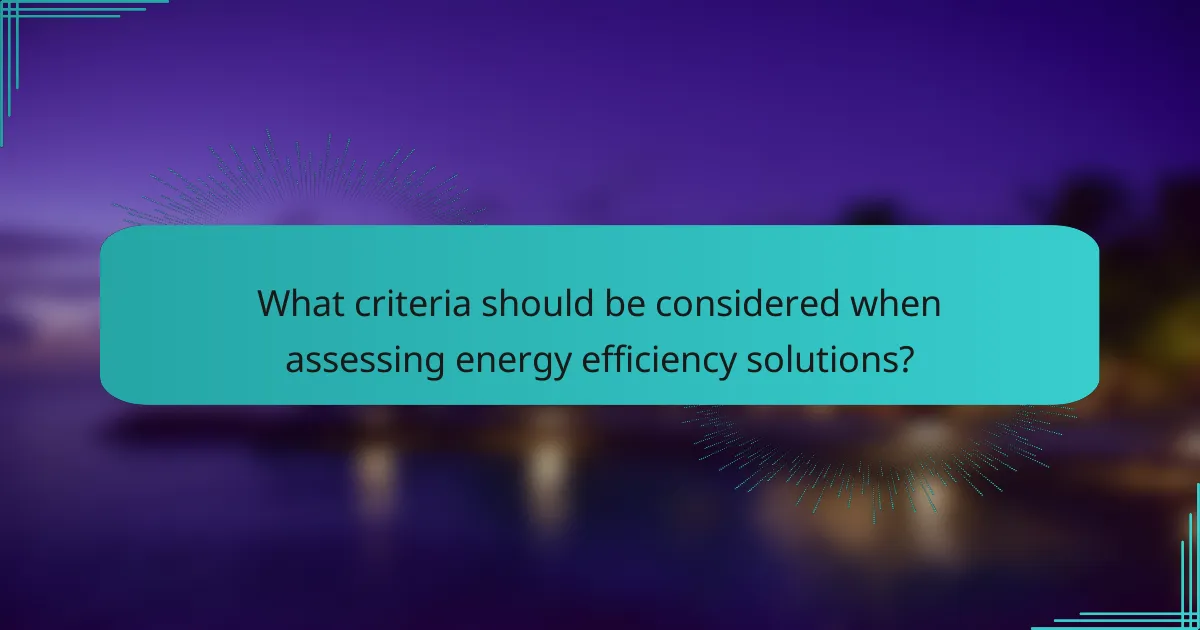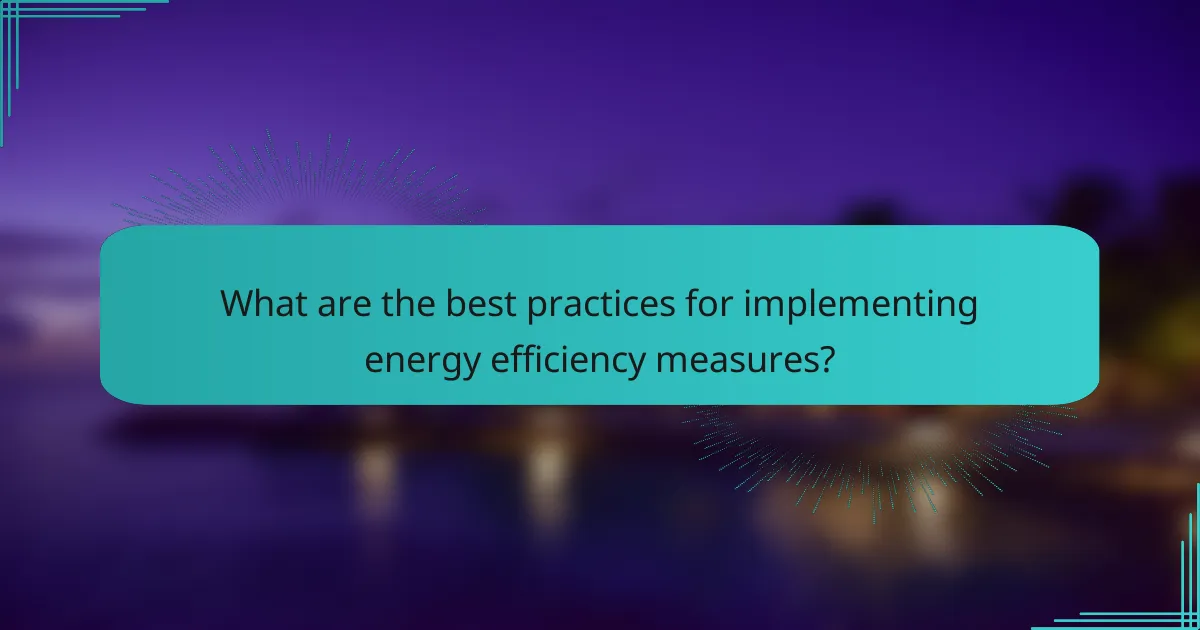Energy efficiency plays a crucial role in lowering costs for both households and businesses by minimizing energy consumption and associated expenses. By adopting energy-saving measures, users not only benefit from reduced utility bills and government incentives but also contribute to a healthier environment through decreased greenhouse gas emissions. Moreover, enhanced energy efficiency leads to greater user satisfaction, as individuals experience improved comfort and financial savings in their living and working spaces.

How can energy efficiency reduce costs in Australia?
Energy efficiency can significantly lower costs for households and businesses in Australia by reducing energy consumption and associated expenses. By implementing energy-saving measures, users can enjoy lower utility bills, access government incentives, and achieve better long-term returns on investments.
Lower utility bills
Reducing energy consumption directly translates to lower utility bills. For instance, upgrading to energy-efficient appliances can cut electricity usage by 20-50%, depending on the appliance type. Simple actions like sealing drafts or using LED lighting can further decrease energy costs.
Monitoring energy usage through smart meters can help identify high-consumption areas, enabling targeted improvements. Regularly reviewing energy bills can also reveal potential savings from switching providers or plans.
Government rebates and incentives
The Australian government offers various rebates and incentives to encourage energy efficiency upgrades. Programs like the Energy Savings Scheme in New South Wales provide financial support for households and businesses that invest in energy-efficient technologies.
Incentives can include cash rebates, tax credits, or low-interest loans, making it more affordable to implement energy-saving measures. Checking local government websites for available programs can help maximize savings.
Long-term investment returns
Investing in energy efficiency often yields substantial long-term returns. While initial costs for upgrades may seem high, the savings on energy bills can recoup these costs within a few years. For example, installing solar panels can lead to savings of thousands of dollars over their lifespan.
Additionally, energy-efficient buildings tend to have higher property values and attract more tenants, enhancing overall investment returns. Evaluating the payback period for energy-efficient upgrades can help in making informed financial decisions.

What are the environmental benefits of energy efficiency?
Energy efficiency leads to significant environmental benefits, primarily through reduced energy consumption, which in turn decreases greenhouse gas emissions and conserves natural resources. By implementing energy-efficient practices, individuals and businesses can contribute to a healthier planet while also enjoying cost savings.
Reduced greenhouse gas emissions
Improving energy efficiency directly lowers greenhouse gas emissions by minimizing the amount of energy required for various activities. For instance, using energy-efficient appliances can reduce emissions by tens of percent compared to standard models.
Transitioning to energy-efficient lighting, such as LED bulbs, can also contribute to lower emissions. These bulbs consume less electricity, which means less fossil fuel combustion at power plants, further decreasing overall carbon footprints.
Conservation of natural resources
Energy efficiency helps conserve natural resources by reducing the demand for energy production, which often relies on finite resources like coal, oil, and natural gas. By using less energy, we can extend the lifespan of these resources and reduce the environmental impact associated with their extraction and processing.
For example, implementing energy-efficient building designs can significantly lower heating and cooling needs, thereby decreasing the amount of fossil fuels required for energy generation. This not only conserves resources but also promotes sustainability.
Improved air quality
Enhanced energy efficiency contributes to improved air quality by reducing pollutants released during energy production. Fewer emissions from power plants lead to lower levels of smog-forming compounds and particulate matter in the air.
For instance, homes that utilize energy-efficient heating systems can help decrease the reliance on older, polluting technologies, resulting in cleaner air for communities. This is particularly important in urban areas where air quality can significantly impact public health.

How does energy efficiency impact user satisfaction?
Energy efficiency significantly enhances user satisfaction by providing a more comfortable living environment while reducing costs and environmental impact. Users often report higher levels of contentment when their energy-efficient systems lead to lower utility bills and improved indoor conditions.
Enhanced comfort levels
Energy-efficient homes maintain consistent temperatures, reducing drafts and humidity levels. This leads to a more pleasant living space, which is particularly important in regions with extreme weather conditions. For instance, homes equipped with high-quality insulation and energy-efficient windows can keep indoor temperatures stable, enhancing overall comfort.
Moreover, energy-efficient heating and cooling systems operate more quietly, contributing to a serene atmosphere. Users often appreciate the lack of noise from older, less efficient models, which can disrupt daily activities and relaxation.
Increased property value
Investing in energy efficiency can significantly boost property value. Homes with energy-efficient features often attract buyers willing to pay a premium for lower operating costs and enhanced comfort. According to various studies, properties with energy-efficient ratings can see increases in value ranging from 5% to 15% compared to similar homes without such features.
Additionally, energy-efficient upgrades can make a property more marketable. Features like solar panels, energy-efficient appliances, and smart home technology appeal to environmentally conscious buyers, making these homes stand out in a competitive market.
Positive user experiences
User satisfaction often stems from the overall experience of living in an energy-efficient home. Many users report feeling empowered by their ability to control energy consumption and reduce their carbon footprint. This sense of responsibility can lead to a deeper emotional connection with their living space.
Furthermore, energy-efficient homes typically require less maintenance, which can enhance user satisfaction. Homeowners appreciate the reliability of modern systems that operate efficiently over time, leading to fewer repairs and disruptions in daily life.

What criteria should be considered when assessing energy efficiency solutions?
When assessing energy efficiency solutions, key criteria include cost-effectiveness, technology compatibility, and regulatory compliance. Evaluating these factors ensures that the chosen solution not only saves money but also integrates well with existing systems and adheres to relevant regulations.
Cost-effectiveness
Cost-effectiveness is crucial when evaluating energy efficiency solutions, as it measures the financial return on investment. Consider both initial costs and long-term savings, which can include reductions in energy bills and maintenance expenses. A solution that saves 20-30% on energy costs can significantly impact overall operational budgets.
To assess cost-effectiveness, calculate the payback period—the time it takes for savings to equal the initial investment. A payback period of under five years is generally considered favorable. Additionally, factor in potential incentives or rebates that can further reduce upfront costs.
Technology compatibility
Technology compatibility refers to how well a new energy efficiency solution integrates with existing systems and infrastructure. It’s essential to ensure that the chosen solution can work seamlessly with current technologies, such as HVAC systems, lighting, and building management systems. Incompatible technologies can lead to increased costs and operational disruptions.
Before implementation, conduct a compatibility assessment to identify any necessary upgrades or modifications. This may involve consulting with vendors or conducting pilot tests to ensure that the new solution will function effectively within the existing framework.
Regulatory compliance
Regulatory compliance is a critical factor in selecting energy efficiency solutions, as many regions have specific laws and standards governing energy use. Understanding local regulations, such as energy efficiency mandates or emissions targets, can help avoid penalties and ensure eligibility for incentives.
Stay informed about relevant standards, such as those set by the International Organization for Standardization (ISO) or local energy authorities. Regularly review compliance requirements to ensure that your energy efficiency initiatives align with current regulations, which can vary significantly by country or region.

What are the best practices for implementing energy efficiency measures?
Implementing energy efficiency measures involves a series of strategic actions that can lead to significant cost savings, reduced emissions, and improved user satisfaction. Key practices include conducting energy audits, upgrading insulation and windows, and investing in energy-efficient appliances.
Conducting energy audits
Energy audits are essential for identifying areas where energy consumption can be reduced. These assessments evaluate the energy use of a building and pinpoint inefficiencies, helping to prioritize improvements. Engaging a certified energy auditor can provide a comprehensive analysis tailored to your specific needs.
During an energy audit, common areas of focus include heating and cooling systems, lighting, and insulation. Homeowners may expect to see potential savings of 5-30% on their energy bills after implementing recommended changes. Regular audits can help maintain efficiency over time.
Upgrading insulation and windows
Improving insulation and replacing old windows can significantly enhance a building’s energy efficiency. Proper insulation reduces heat loss in winter and keeps interiors cool in summer, leading to lower heating and cooling costs. Double or triple-glazed windows can further minimize energy loss.
When considering upgrades, look for materials with high R-values for insulation and energy-efficient window ratings. Depending on the size of the home, homeowners might invest anywhere from a few hundred to several thousand dollars, with payback periods typically ranging from 5 to 15 years based on energy savings.
Investing in energy-efficient appliances
Energy-efficient appliances consume less electricity and water, contributing to lower utility bills and reduced environmental impact. Look for appliances that have the ENERGY STAR label, which indicates compliance with energy efficiency guidelines set by the U.S. Environmental Protection Agency.
When replacing old appliances, consider the long-term savings versus the initial investment. For example, an energy-efficient refrigerator may cost more upfront but can save hundreds of dollars over its lifetime. It’s advisable to calculate the estimated annual energy costs of new appliances to make informed decisions.

What are the emerging trends in energy efficiency in Australia?
Emerging trends in energy efficiency in Australia focus on integrating advanced technologies and increasing the use of renewable energy sources. These developments aim to reduce costs, lower emissions, and enhance user satisfaction in energy consumption.
Smart home technology integration
Smart home technology is revolutionizing energy efficiency by allowing homeowners to monitor and control their energy use in real-time. Devices such as smart thermostats, lighting systems, and energy management apps can optimize energy consumption based on user behavior and preferences.
For instance, smart thermostats can learn a household’s schedule and adjust heating or cooling accordingly, potentially saving up to 10-15% on energy bills. Homeowners should consider compatibility with existing systems and ease of use when selecting smart devices.
Renewable energy adoption
The adoption of renewable energy sources, such as solar and wind, is a key trend in improving energy efficiency in Australia. Many households are installing solar panels to generate their own electricity, which can significantly reduce reliance on the grid and lower energy costs.
Government incentives, such as rebates and feed-in tariffs, encourage this transition. Homeowners should evaluate the initial investment against long-term savings and consider local regulations regarding solar installations to maximize benefits.


